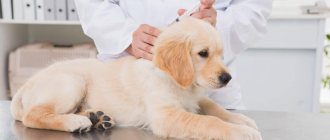General information
Canine parainfluenza is a viral disease that affects the dog's upper respiratory tract: nose, larynx, bronchi and trachea. This is a problematic infection transmitted by airborne droplets. In some ways, parainfluenza in dogs is very similar to a human viral infection. Likewise, it is extremely contagious and can only be contracted from a single contact with a carrier of the disease. In addition, it is during the cold seasons that the largest number of cases is recorded.
The virus is not dangerous to people because it is not able to withstand the human body's immune system. Is parainfluenza transmitted from dog to cat? In veterinary practice, cases of a similar disease in furry creatures have been recorded, but they are extremely rare.
Parainfluenza is not life-threatening for the animal, but it can develop into pneumonia or have even more serious complications. That is why it is important to immediately consult a doctor at the first symptoms of your pet’s illness.
Pathogen information
The disease is viral in nature, caused by a pathogen from the paramyxovirus family. In general, there are many questions with this. The fact is that there is still debate among veterinarians and microbiologists about the specific pathogen. So far, everyone agrees that the pathology should be recognized as some kind of general case of damage to the upper respiratory tract by a whole complex of pathogens (including bordetellosis). Accordingly, no specific treatment has yet been invented. There is only general, symptomatic therapy that “suppresses” the main symptoms.
Let us immediately put to rest those owners who do not know whether this virus is contagious to humans. No, it does not pose any danger to you and your household, so there is no need to worry about this. Of course, this does not eliminate the need to urgently take the dog to a veterinary clinic.
Infection
Parainfluenza in dogs is a very unpleasant phenomenon. It spreads by airborne droplets almost instantly. As soon as a sick animal gets close to a healthy one, infection immediately occurs. A pet can easily catch parainfluenza in a place with a large concentration of dogs: at a dog show, on a walk, in a shelter. Even if an animal is vaccinated and is not sick itself, it can be a carrier of the disease.
The virus enters the body through the mucous membranes of the dog. Parainfluenza is considered not a particularly dangerous disease, but it can cause serious complications in individuals with reduced immunity.
Animals at risk
Dogs of all breeds suffer from parainfluenza. The following are at risk of infection:
- puppies up to one year old;
- emaciated dogs suffering from malnutrition;
- animals suffering from other diseases with weakened immunity;
- pregnant and lactating dogs;
- injured or recently operated pets.
Factors that increase the likelihood of infection:
- frequent stressful situations;
- lack of vaccination;
- poor quality nutrition that does not contain enough vitamins and minerals;
- infection by parasites and fungus;
- “sedentary lifestyle”: lack of sufficient exercise and fresh air;
- keeping on the street.
Symptoms
The main symptoms of parainfluenza in dogs can be identified:
- after vigorous exercise, the dog begins to have a strong dry cough;
- the animal eats well, but begins to drink water more often;
- the pet becomes lethargic and apathetic;
- you can observe mucous discharge from the nose;
- the dog begins to vomit;
- conjunctivitis and discharge from the eyes;
- body temperature rises.
When listening to the cavity of the respiratory organs, whistles and wheezing are observed. When the veterinarian palpates the throat and chest, the dog may feel discomfort and cough.
The symptoms are usually most severe in puppies and older dogs, because their immunity is weak and is not able to effectively cope with the disease. You can often note signs that are uncharacteristic of this disease.
Symptoms of the disease
The incubation period of the disease ranges from three days to a month and is asymptomatic. At the end of the test, the sick pet shows the first signs of infection associated with an increase in the concentration of the virus in the blood. These include:
- The appearance of increased lacrimation, photosensitivity.
- A cough that gets worse even with minor physical exertion.
- Increase in body temperature (usually slight).
- Decreased activity. With this disease, even a cheerful, playful dog will refuse to go for walks, sleep a lot, and move sluggishly around the apartment.
- Loss of appetite, refusal of favorite food.
As the disease progresses, the symptoms of parainfluenza will become more intense. The animal may experience purulent discharge from the eyes, a strong increase in temperature, increased thirst, shortness of breath, and wheezing. In the intestinal form of the disease, diarrhea or vomiting is added to the presented symptoms. In this case, the pet loses the ability to control the process of defecation.
7-10 days after the onset of the acute stage of the disease, the pet will begin to produce antibodies to the pathogen, and the concentration of the virus in the blood will decrease. In this regard, his symptoms of the disease will gradually disappear. In a few days, complete recovery will occur.
If the dog’s immunity is weakened, a secondary infection may develop against the background of parainfluenza. In such cases, complications of the disease often appear: bronchitis or pneumonia. They can lead to hypoxia, pulmonary edema, and death of the pet. Antibacterial therapy can save the life of a puppy with such pathologies.
Course of the disease
The incubation period of the disease lasts from 2 to 30 days. At this time, the dog seems healthy and does not show symptoms, but it is already a carrier of the virus.
At the beginning of the disease, as a result of physical activity, the dog begins to cough. The animal's activity decreases and it becomes apathetic. You may notice a drop in appetite, a reluctance to go outside, and watery eyes. The temperature may rise to 40-40.5 degrees.
If parainfluenza, due to reduced immunity, is not accompanied by any other diseases, then recovery should occur in 1-2 weeks. The body produces antibodies that resist the virus.
However, it is worth noting that parainfluenza is often accompanied by other viral and bacterial diseases: herpesvirus, adenoviruses. In this case, the course of the disease becomes more complicated, and symptoms that are not characteristic of this disease may be present. A very high temperature may occur, a serious decline in the animal’s activity, the appearance of pneumonia, purulent discharge from the eyes, severe shortness of breath, and great thirst.
Often, as a complication of parainfluenza, the infection spreads to the stomach. The dog does not eat and has severe diarrhea. In this case, it is necessary to urgently consult a doctor, otherwise the animal may die from exhaustion.
How does the disease begin?
With parainfluenza, the dog refuses to eat and becomes lethargic. Parainfluenza in quadrupeds manifests itself as follows:
- The conjunctiva turns red, pale mucous membranes become anemic.
- Serous-purulent or purulent discharges are discharged from the organs of vision, as well as from the nose.
- Appetite decreases, the dog begins to refuse both its usual food and treats.
- Strong thirst appears, the dog drinks a lot of water.
- The dog becomes apathetic, drowsy, and its physical activity noticeably decreases.
- Respiratory function is impaired.
- Severe shortness of breath develops.
In the first days of infection activity, body temperature rises sharply. Its indicators can reach 40-40.5 degrees.
Important. The main clinical sign is a painful dry cough.
Prolonged coughing attacks appear against the background of physical activity.
Shortness of breath initially occurs only after walking. But as parainfluenza progresses, it is present even when the dog is at rest.
Pathology progression
If parainfluenza is not very severe, the following symptoms are observed:
- chest pain;
- whistling while breathing;
- wheezing while breathing.
In severe cases, bowel dysfunction may occur. The dog's stool becomes very runny. The pet may feel sick and vomit.
Concomitant pathologies
Parainfluenza occurs against the background of:
- Pneumonia.
- Pharyngitis.
- Tonsillitis.
Less commonly, tracheitis or bronchitis occurs simultaneously with parainfluenza.
Pathogens
The causative agent of parainfluenza in dogs is a pathogen from the paramyxovirus family. In 1967, as a result of a study in the United States, viruses of this family were discovered in a large number of sick dogs. Later, paramyxoviruses began to be observed in other sick animals around the world. However, the exact source of this disease has not yet been determined. As the infection progresses, the dog’s body is attacked by a huge number of harmful microbes, and it is almost impossible to identify the main culprit of the disease. The virus multiplies in the mucous membrane of the upper respiratory tract and in the lymph nodes. Sometimes it spreads to the lungs, intestines and spleen.
At room temperature in the external environment, the virus dies within four hours. It instantly dies at 55 degrees.
As a result of exposure to a virus and bacterial infection, infectious tracheobranchitis may occur. This disease is quite severe, and it is much more difficult to treat than ordinary parainfluenza.
Etiology
that the disease is viral in nature in 1967. They identified its causative agent, which belongs to the paramyxovirus family. This is not to say that parainfluenza did not exist before this year, but that is when it was identified and included in the definitions. In subsequent epizootics, microbiologists already knew what to look for and therefore made a very definite diagnosis.
The parainfluenza virus spreads by the usual route for this type of microorganism – airborne droplets . It multiplies on the mucous membrane of the upper respiratory tract and in the lymph nodes closest to them. The incubation period depends on the state of the animal's immunity. Usually the first signs of the disease appear after 2-3 days , but there are cases when it began a month later, after contact with a sick animal.
The virus is very active, so the rate of spread of kennel cough in dog groups is high. However, one cannot assume that individual walks or communication only with trusted individuals is a sufficient reason to protect against it. , which occurs, for example, during transportation, change of owner, or at an exhibition, can also be a provoking factor for the disease
Individuals with weakened or undeveloped immunity are most susceptible to parainfluenza:
- Young dogs up to one year old.
- suffered serious illnesses with helminthic infestation or skin parasites, including mites and all types of fungal diseases (ringworm, etc.).
- Bitches during pregnancy and lactation.
Diagnostics
Even if a dog exhibits all of the above symptoms, you should not diagnose the animal yourself. Many diseases have similar manifestations, so only a specialist can identify the type of infection by taking tests and conducting the necessary research. Since the exact causative agent of the disease is unknown, the doctor prescribes treatment based on the most likely causes.
The veterinarian must conduct an external examination, obtain the results of the anamnesis, and perform laboratory tests. For diagnostic purposes, an ultrasound of the respiratory tract is performed, biological material is taken from the pharynx, nose and trachea, and a general blood test is performed. Due to the similarity of parainfluenza with many other diseases, the doctor is obliged to conduct a differentiated diagnosis. In case of acute symptoms, it is necessary to exclude pneumonia, bronchitis, plague, and heart failure from the list of possible diseases.
Treatment
If parainfluenza has not yet completely taken over the dog’s body, and the symptoms are not severe, the vaccine is quite capable of killing the disease in the early stages.
With a mild form of the disease, it is enough for the dog to take tablets that increase immunity. To treat an acute illness, the doctor usually prescribes broad-spectrum antibiotics to avoid unwanted complications. Anti-cough medications are prescribed infrequently - only if the animal has a severe and painful cough.
If your pet has a high temperature, he is given antipyretics and recommended to drink a lot of water. Sometimes the drugs are administered intravenously.
During illness, excessive activity of the dog should be avoided. It is worth giving her balanced, vitamin-rich food.
If the animal is sick, you should refrain from socializing your pet with other dogs to avoid infecting them. The parainfluenza virus is most active during 4-9 days. It is worth knowing: if proper treatment has not been carried out, even if all the symptoms of parainfluenza in a dog have disappeared, this does not mean that the body has completely defeated the disease. Perhaps the infection has entered into symbiosis with the body, and the dog is a dangerous carrier of the virus to others.
Symptoms, clinical manifestations of canine parainfluenza
The incubation period for dogs infected with parainfluenza ranges from several days to a month. The intensity of the manifestation depends on the general physiological state of the animal, the state of immunity, and conditions of detention. The duration of the disease, as a rule, is 7-10 days and ends with recovery if effective treatment was prescribed in a timely manner.
In weakened dogs, the disease can provoke serious complications, which can manifest themselves in the form of pneumonia, bronchitis, and chronic catarrh of the upper respiratory tract. With a protracted form of canine parainfluenza, the disease can develop into virus carriage. In this case, the dog does not have outwardly noticeable characteristic clinical symptoms, but the animal is a carrier of a dangerous virus.
In newborn puppies, the parainfluenza virus can affect various organs and systems, ending in viremia, in which the pathogen is localized in the cellular structures of the bloodstream. Puppies from ten days of age are susceptible to infection.
The main clinical manifestation of parainfluenza in dogs is a lingering dry cough, attacks of which intensify during exercise.
Symptoms of parainfluenza in dogs:
a sharp increase in temperature in the first days after infection to 40-40.5 degrees;
decreased physical activity, lethargy, drowsiness, apathy;
decreased appetite, refusal to feed, severe thirst;
respiratory dysfunction, shortness of breath;
serous, serous-purulent discharge from the eyes, nose;
pallor, anemia of the mucous membranes, redness of the conjunctiva.
In severe cases, attacks of vomiting, diarrhea, and pneumonia are possible. During auscultation, strong wheezing and whistling are heard in the lungs, and pain in the sternum is also noted. The disease occurs in the form of tonsillitis and pharyngitis. Less commonly, bronchitis and tracheitis are diagnosed in dogs against the background of illness.
Important! In dogs, parainfluenza is often a secondary infection that worsens against the background of other infectious viral diseases. Parainfluenza infection is often complemented by other respiratory diseases - adenovirus infection, canine distemper virus, canine reovirus, herpes virus.
If you contact a veterinary clinic in a timely manner, the prognosis for the disease is favorable. The main thing is not to delay a visit to a veterinarian if the dog’s general condition worsens and the first clinical symptoms of parainfluenza appear!
Prevention
Only vaccination can help avoid the occurrence of this disease in a dog. The first of them is done to puppies at 5-6 months of life. Further, certain doses are administered every month. Upon completion of the course, dogs are given an injection of parainfluenza vaccine annually. There is no particular need for this manipulation if the pet does not have contact with other dogs. Although here it is worth considering that this disease is easily transmitted on human clothes.
It is necessary to pay close attention to the hygiene of the animal and the place where it is kept. The dog needs to live in cleanliness. Her enclosure, booth, and room must be constantly cleaned and disinfected. Your pet's menu should contain all the necessary vitamins and minerals.
Hypothermia is dangerous for the animal. You should not let your wet pet outside. If your dog gets caught in the rain, you need to dry and warm him up as quickly as possible. Drafts are also very undesirable.
Parainfluenza is most dangerous for animals with weakened immune systems. It is worth remembering that stress causes a decrease in the body's resistance to disease. It is necessary to provide the animal with the most comfortable living conditions.
Although parainfluenza is not dangerous for humans, the owner of a furry creature can carry it on his skin, clothes and shoes. That is why it is important to adhere to all the rules of personal hygiene when interacting with your pet.
So, we found out that parainfluenza in dogs is not the most dangerous disease, and in most cases it is easily treatable. However, it is worth remembering that even its mildest form can lead to bad consequences. Therefore, you should not take it lightly. At the first symptoms of the disease, you should urgently take your dog to the veterinarian and get tested for parainfluenza.
Prevention of parainfluenza
It is imperative to vaccinate your dog annually and pay special attention to the conditions in which the animal is kept. Specific prevention involves the use of monovaccines.
Scientists from the USA found out that the disease is viral in nature in 1967. They identified its causative agent, which belongs to the paramyxovirus family. This is not to say that parainfluenza did not exist before this year, but that is when it was identified and included in the definitions. In subsequent epizootics, microbiologists already knew what to look for and therefore made a very definite diagnosis.
The parainfluenza virus spreads by the usual route for this type of microorganism – airborne droplets. It multiplies on the mucous membrane of the upper respiratory tract and in the lymph nodes closest to them. The incubation period depends on the state of the animal's immunity. Usually the first signs of the disease appear after 2-3 days, but there are cases when it began a month later, after contact with a sick animal.
The virus is very active, so the rate of spread of kennel cough in dog groups is high. However, one cannot assume that individual walks or communication only with trusted individuals is a sufficient reason to protect against it. Stress, which occurs, for example, during transportation, change of owner, or at an exhibition, can also be a provoking factor for the disease.
Individuals with weakened or undeveloped immunity are most susceptible to parainfluenza:
The causative agent of canine parainfluenza is a virus of the paramyxovirus family (strain CPIV). In addition, the causative agent of the disease is localized in the regional lymph nodes of the dog. The parainfluenza virus is localized in the epithelium of the nasal cavity, larynx, trachea, bronchi, and nasopharynx. In some cases, the virus is isolated from the lungs, intestines, and spleen.
Infection of pets occurs through airborne droplets through close contact with infected individuals. Parainfluenza is often called “kennel disease”, “kennel cough”, since dogs most often are at risk when kept in groups in kennels and enclosures.
The danger of contracting a dangerous respiratory disease occurs when the body’s resistance decreases, in weakened animals, puppies with immature immunity, as well as in dogs kept in unfavorable conditions. Dogs can catch parainfluenza through contact with homeless and stray animals, at exhibitions, competitions, and in public dog-walking areas.
A dog can become infected with a respiratory infection under stress, for example, when changing its owner, since stressful situations significantly weaken the body and reduce immunity. Infection of a dog with parainfluenza is also possible during transportation in violation of the rules for transporting dogs. In most cases, the disease is diagnosed in unvaccinated, unvaccinated animals of any age.











